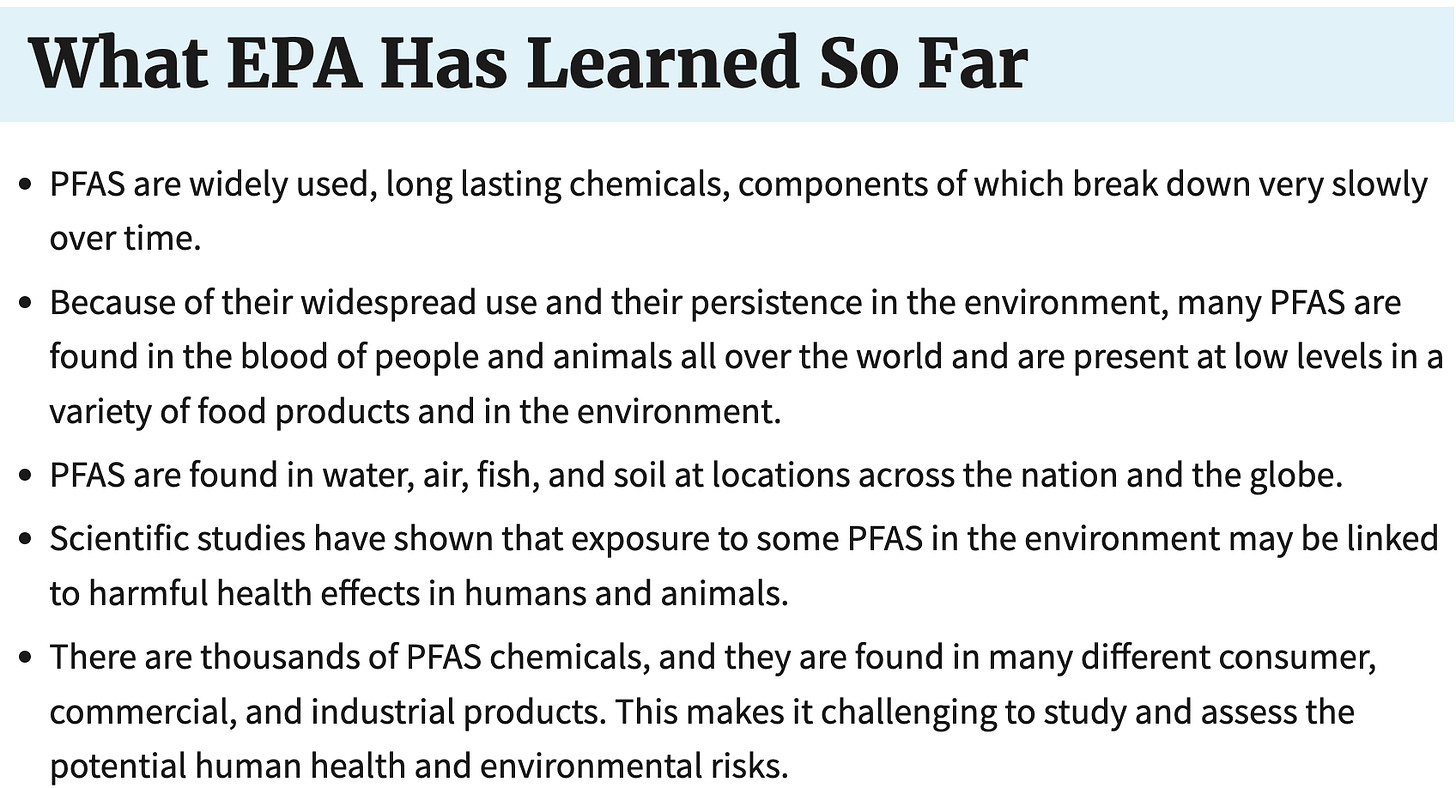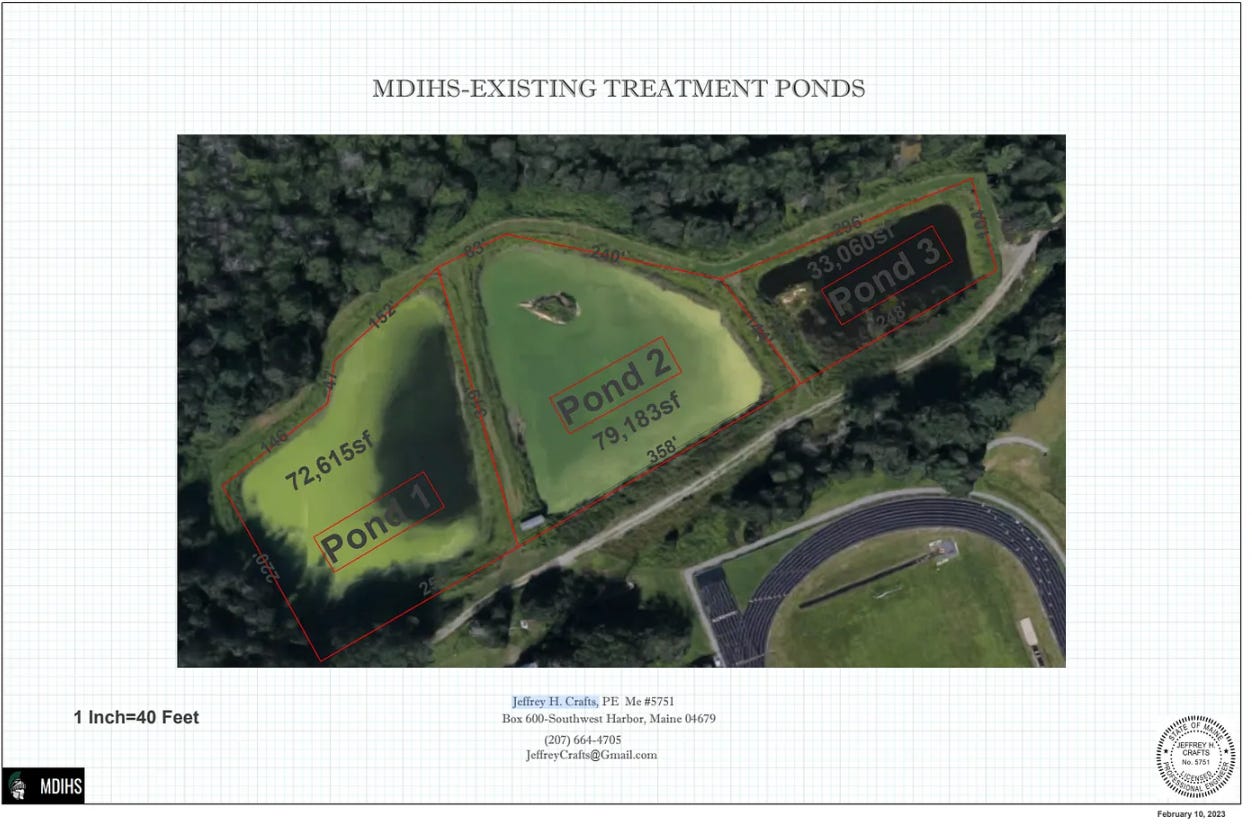What to Do With the Poo? And Other Waste Water, Too
MDI High School Trustees ponder possible remedies to deal with wastewater issues
BAR HARBOR—There are three current options to potentially fix issues with MDI High School’s big wastewater problem.
Monday night’s meeting of the MDI High School Board of Trustees included new data regarding PFAS site tests results and a draft letter from consultants Haley Ward speaking to those three possible remediations to the school’s wastewater treatment system.
PFAS are considered “forever chemicals.” The report on all Maine schools is here.
The draft letter from Haley Ward is dated July 21, 2023 and delves into the history of the school’s wastewater treatment system, recent occurrences with the system, and options for the wastewater system moving forward.
The current system, constructed in 1968, utilizes a 37,000-gallon septic tank, two lagoons, and a treated water spray system. A third lagoon was added to the system in 1988 but that lagoon was taken out of service earlier this year. The spray system operates under a Maine Waste Discharge License and the school is allowed to spray between the dates of April 15 and November 15. The treated water that is sprayed onto a 3.85-acre field.
The permitted spray discharge ranges from 27,150 gallons per acre per week to 95,025 gallons per acre per week. That amounts to a possible total spray amount of 104,527.5 gallons to 365,846.25 gallons per week. According to Haley Ward, the system of spray nozzles that disperse the treated water onto the 3.85-acre irrigation field are set up so that the water is sprayed in a circular pattern that is 90 feet in diameter.
The MDIRSS has received two notices of violations from the Maine Department of Environmental Protection regarding the wastewater treatment system. The first was in June 2003 and the second was July 2023. Both of the violations were in relation to discharge of water from the lagoons that were not permitted into the adjacent wetlands. Both violations were discovered during routine water level monitoring of surface water elevations by the school staff responsible for the wastewater system.
It is not known for sure how water may be leaking from the lagoons. The lagoons are lined with clay which is a less permeable substance than many soil types, but they are not lined with any manufactured liner such as a HDPE. The assumption being made by those involved is that the water is either permeating through the lagoon berms or seeping through the clay surface and into the ground underneath the lagoons. In addition, the lagoons are susceptible to animal damage.
At Monday night’s meeting, Scott Watson, director of maintenance for the high school said, “Muskrats have dug holes through the berm and clay lining.”
SCHOOL WASTEWATER DEMANDS
Haley Ward states that the current discharge of waste water from the high school is approximately 9,300 gallons per day. This water comes from restrooms, water fountains, maintenance and janitorial usages, and the kitchen. According to the school’s calendar, the school year is roughly 200 days long. This means that there is an approximate total demand of 1.86 million gallons per year, not including summer activities etc.
The waste water flows into the septic tank first, and at 37,000 gallons, there is an approximate four-day water retention period to allow for the solids to separate from the liquid and settle to the bottom. The water then flows into the lagoon system, initially flowing into lagoon one, via gravity.
The capacity of the two remaining lagoons is unknown but is estimated to be approximately 4.2 million gallons. This capacity, according to an estimation by Haley Ward, would allow for a water retention period of approximately 268 days prior to the water being sprayed onto the irrigation field. This time frame allows for further separation of solids and other byproducts to detach from the water in the two lagoons. All water sprayed onto the irrigation field comes from lagoon two.
According to this draft report, the PFAS levels from samples taken from the lagoon water were as high as 40 parts per trillion. The standard for PFAS levels in drinking water, which is the only set maximum level, is 20 parts per trillion. There are no limits on PFAS levels for non-drinking water and soils.
REMEDIATION ALTERNATIVES
Haley Ward gave three possible scenarios for the future of the high school’s wastewater treatment system:
Reconstruct or rehabilitate the existing system,
Create a fully subsurface wastewater disposal and treatment system,
Install a wastewater main to connect with the Somesville wastewater treatment plant.
REHABILITATING THE EXISTING SYTEM
Rehabilitating the existing system would include an analysis of the condition of each piece of the system, specifically the septic tank and the lagoons. The condition of the septic tank is unknown and an inspection of the tank would be necessary to identify any clogs or cracks that could lead to inefficient operation or leaks. Currently, there are no known leaks.
The lagoons would have to be drained of their water and have existing sludge removed. The clay lining would have to be inspected and any areas where there was a danger of puncture to a new membrane lining would have to be fixed. Then the lagoons would have to be lined with a geomembrane which typically have a useful lifespan of 30 years.
According to Haley Ward’s report, sludge removal typically requires testing of the sludge to determine the best manner of disposal and then a drying out period, although sludge can sometimes be removed with a slightly higher moisture content. It is difficult to determine the cost and proper removal process without access to the sludge for testing.
The last step recommended by Haley Ward would be the installation of a fence around the irrigation field where the treated wastewater is sprayed. The benefits of rehabilitating the existing system are that it would be the fastest and most cost friendly upgrade and has lower maintenance requirements.
CREATING SUBSURFACE WASTEWATER SYSTEM
A subsurface wastewater disposal and treatment system would require the same inspection of the septic tank mentioned above. Then a leach field of approximately 30,000 square feet, based upon Haley Ward’s calculations, would have to be installed. The exact size of the leach field would be based upon the soil characteristics of the area chosen for installation. Because of previous soils tests performed in the area of the current irrigation spray field, it appears to have mostly good drainage and would be a good area for the leach field based upon that drainage and the size of the area.
This septic and leach field system would operate the same as a system installed at a residence or commercial building without access to a wastewater treatment plant. After the wastewater passes through the leach field, it is slowly released into the subsurface soil surrounding the leach field.
The remaining step of this option would be taking the existing lagoons out of service. This would require the same steps as installing the liner: draining of the water and testing, dewatering, and removal of the sludge. The benefits of the subsurface system are that it also has lower maintenance requirements and there would be no spraying of treated water onto the irrigation field.
CONNECTING TO THE SOMESVILLE WASTEWATER TREATMENT PLANT
The final option is to install a wastewater main that connects the schools wastewater outflow to the Somesville wastewater treatment plant.
The Somesville wastewater treatment plant is located approximately four miles from the high school and has a pump station located approximately two miles away from the high school. The topography of the land would allow gravity to carry the waste water to the intersection of Route 233 and Route 3. At that point, a new pump station would have to be installed to pump the waste water to the existing pump station.
The Somesville wastewater treatment plant has a capacity of 80,000 gallons a day and operates in the daily range of 25,000 to 30,000 gallons per day. It is not expected that the high school’s average outflow of 9,300 gallons per day would overwhelm the treatment plant. In fact, according to Haley Ward, representatives of the treatment plant would welcome the added waste water to help the system run more effectively during times of lower outflows from customers. Many of the customers of the treatment plant are seasonal users and the steadier year-round usage would be beneficial for the plant.
This would of course be the costliest of the three options. There are the initial costs of building the system, which would most likely include removal of rock and ledge to make way for the wastewater main, construction of the piping system and accompanying equipment to include the purchase and installation of the pump station. This would also be the project that takes the most time to complete.
Additionally, there would be ongoing equipment maintenance costs and fees to the treatment plant along with the price of decommissioning the existing system, to include the lagoons.
This system would allow for expansion of the school, whether it be a larger student and staff population or the addition of future buildings, or both. In terms of the environment, this is basically a closed system and outside of pipe failures or leaks; there is no exposure of the subsurface soils to the wastewater or any of the contaminants that they may contain.
All three of these options require a significant monetary and time investment. These types of construction projects require the involvement of many private companies and state and federal entities and the decision on which way to proceed requires lengthy and careful thought. Haley Ward’s draft letter has cost estimation lines that are currently blank. The community, via their elected school system representatives, will have to determine which option benefits everyone the most and not necessarily pay attention to those cost estimation lines once they are filled in.
There is a component of this article that has to do with recent PFAS testing that took place in multiple locations on and nearby the school’s campus. The Bar Harbor Story verbally asked MDIRSS Superintendent Mike Zboray for the test data and test site locations on Monday and has had email correspondence regarding this public data with Zboray twice since then but still has received nothing. We will update this article or write a second article once we have received the requested information.
LINKS TO LEARN MORE
The Chemicals That Don't Go Away
BAR HARBOR—Before the public forum about forever chemicals and wastewater began at MDI High School Monday night, people murmured as they sat down in the chairs in the high school’s music room. They murmured about sharing information, about whether the high school or state would consider paying the costs to residents to check their wells for forever chem…
Candidate Forums, Marina Plans, Road Closures, School Construction, and PFAS
I’m, again, trying to keep the amount of emails to your inbox a bit lower this week. That means we’re combining things a bit. And we might not be quite as fast to get things out. Let me know if you prefer it this way, but only if you feel like it.
https://haleyward.com/leadership-team/
Yesterday, the national press noted that Maine joined 21 other states rejecting a $10.3 billion deal with 3M PFAS water litigation. That story’s link is below.
https://news.yahoo.com/nh-maine-among-22-states-115153661.html










